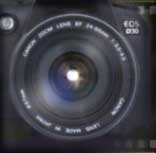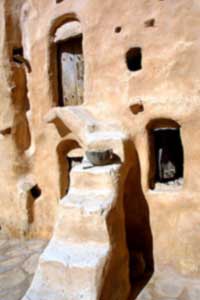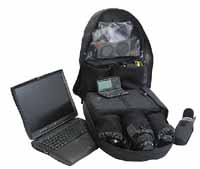Go straight to:
[How many pixels?]
[Storing your photos]
[Security of your gear]
[Mobile power]
[Getting around]
Part 2
[The learning curve]
[Insurance]
[Cost]
[Keep it clean]
[Travel photography]
We can send you a free pdf of this article. Send us a request: File size 220kb
Travelling with a digital camera
(or "Did you pack the pixels?")
by Richard Dobbie
Part 1
Going digital was a decision that was only made after a long period of thought.
I have used film forever; somewhere in the dim dark past slides were my favourite form of recording an image, but the time and trouble involved in getting the projector out and set up meant that we didn't look at our photos all that much.
So prints became the order of the day. You can just pull out the album and flick through those memories on a whim.
Site Links:
KL of Dallas writes "Really good site! Your tips are excellent reminders. I have already been researching storage and security devices for traveling and the products you mention sound perfect for my needs."
Then I became interested in web publishing. Scanning the prints was a reasonable way to go, but time consuming. So that's when I started to consider a digital camera.
But wait a minute, the quality of the images from these digital cameras isn't all that good, is it?
So I waited, thought, and waited. Canon released their D30 and I started to get interested. It seemed like I could have all the advantages - use my existing Canon lenses and get a reasonable digital file size (3.25 million pixels) at the same time. But the cost, could I justify buying the D30? No probably not, but I bought it anyway!
So, here are my tips about selecting and traveling with a digital camera:

The Canon EOS D30 is an SLR type digital camera. This means that the camera has an interchangeable lens system which gives you more flexibility that a fixed lens system. Canon have recently released two more professional level SLR digital bodies with higher pixel counts and additional features (the D1 and the D60 - the D60 has now been replaced by the D10, nothing stands still in the digital world).
A good place to find out about digital cameras is http://www.dpreview.com where the above image came from.
Got a tip?
about traveling with a digital camera? Why not share it? Send your tip to rcdobbie@alphalink.com.au
1. How many pixels do you need?
The more pixels you can afford the better, but before you buy, consider what you will be doing with your photographs. If it is just simply posting to a web site or attaching to emails, then there is no need to pack so many pixels and one of the cheaper cameras is probably going to suit your needs. If you intend to print your photos for album or display, or you are an enthusiast and want some camera features, then the cheaper point and shoot digitals are not going to satisfy you. If you want good quality prints of up to 10X8 inches (A4 size), then you need a camera that will produce photos of 3 million pixels or more. As your pixels increase, then you need a decent lens system to take advantage of them.
Remember also that the quality of your printed photograph is also dependent on your printer's capability.
If you are an enthusiast, then you will know what you want as far as camera features go, and you should buy as best as you can afford.
Remember that whatever you buy, it will probably be superseded by a bigger and better model within a short period of time.
One of the problems with digital cameras is that, unless you go for a SLR type camera like the Canon D30 or Nikon's D1, it is difficult to option up at a later date; but I guess we have always had that situation with film cameras anyway. If you are not an enthusiast, just buy a point and shoot digital and have fun. If you find you want more features at a later date, then look at the higher end cameras.

With a digital camera you won't need to look for a film processing shop again.

The Christmas card we emailed to our friends from Rome, 2001 with Christmas images we had taken around the city just a few days before.
2. No more film
Remember your last holiday - how you looked for the camera shop so you could buy more film or get a roll developed? Then if you had put some film in for development in a strange city, the fun you had trying to find the processing shop again?
When you travel with a digital camera all this is a thing of the past, but you still need to store your shots.
There are two sorts of storage you need to consider here - how many shots can you store on your camera while you are out shooting for the day; and how many shots will you need to store while you are away on holiday.
My recommendation would be to purchase a camera that uses the compact flash storage cards, and buy cards to suit your needs. I use a 256mb compact flash card that stores around 180 photos (more if I reduce the quality) and that gets me through a day's shooting. Yes, with a digital camera you will take more photos than you did with film because that extra shot costs you nothing until you decide to print it. You will also learn faster about exposure and other shooting techniques because you will see the result instantly and have the chance to re-take the shot. I also carry a smaller back-up compact flash card, just in case.
You will need to consider how many shots your camera batteries will take - there is no point in having a huge storage capacity if your batteries give out before you fill your card.
When you struggle back to your hotel that night, you have two options - download the digital files to a storage device, or use a laptop.
There are many portable storage devices on the market and some are quite small but big in capacity. The problem with some of these devices is that you can't see your photos on the big screen.
An option to consider is the Nixview storage device which you can connect to a television screen to view your photos. Have a look at this extensive list for links to a range of products.
I can assure you that with a laptop, you will get a lot of enjoyment out of your photos. It is great being able to review the day's shots and relive the experiences you had. It also gives you the opportunity to do some image adjustments, and sort and file your photographs while the details are fresh in your memory.
And take your mouse with you. If you intend to do some image adjustments, trying to use the laptop's inbuilt cursor control for this type of operation is frustrating. I use a graphics tablet which makes life much easier when you are adjusting images.
Using a laptop also enables you to send some fantastic emails back home. We prepare our letters fully illustrated with photographs and then convert them to pdf documents, save the files to a floppy, and then slip in to the nearest internet site and attach the files to an email.
There are now internet access shops everywhere. In some, they do not allow you to upload from a floppy disk because of virus concerns (they have the floppy drive on their machines locked), but you can usually ask them to scan the disk and make the files available to you for attachment to your email. Just ask, they are always pretty helpful.
Next time we go overseas, rather than attach the files to emails, we will update our website and send the link.
(The pages on Travelsnapz.com this website are based on the email letters we have sent to friends while we have been travelling.)
If you are looking for a good summary of what digital cameras are around, check out:
Digital Camera HQ
Good links to a range of pro and owner reviews.
3. Security
With all this extra equipment - the laptop or a storage device, a battery charger, cd's, cords and cables - the weight of your camera gear starts to mount up. So you won't want to carry everything with you all the time. And what happens when you want an evening out and you leave your camera and gear in the hotel room? I have seen many hotel room doors left wide open by cleaning or maintenance staff when they have gone to fetch another towel or something. Yes, you need to be able to store everything securely.
In this world there are no guarantees, but I get a great deal of peace-of-mind using a pac-safe device (http://www.pac-safe.com).
This is a simple high tensile wire cage that you can place over a bag to secure it. I usually lock it onto a heater or bed frame so I don't have to worry about what is left in the hotel room when I am out during the day or at night.
[Read our Scams and Swindles article for more about security]
Tip: Digital images are immune to x-ray damage, regardless of whether they are stored on camera memory cards, floppy disks or CD-ROMs. But watch out for magnetic fields!
4. Power and other mobile requirements
You will need to access power to run all the equipment you have and to recharge batteries etc. If you are going overseas, then you can purchase a converter plug. I would suggest you also consider surge protection as well. And take a double adapter or purchase one when you arrive overseas. Often in hotel rooms there will only be one power outlet, so a double adapter is handy if you want to watch television while you charge your batteries.
If you are travelling through a country with a different voltage system, then you will need an adapter. Try an electronics supply store for suggestions, but consult your equipment manuals as well.
An extension lead is also handy especially if you want to do some serious work on the laptop - they just don't have power outlets near the desks in hotel rooms.
If you are going to use your laptop to access the internet or to fax, then an appropriate telephone cable will be needed. If you are travelling internationally, then suitable telephone jacks or an acoustic coupler will be required.
Rather than keep all these leads and plugs in my camera bag, I store them in a small cloth bag that I keep in my other luggage. When I move to another location, I always pack my things in the same order - that way you are less likely to forget a cord or a plug.
Take some extra disks or storage cds, but don't over do it - you will find that these consumables are quite widely available.

The Lowe Pro camera bag that I use. Enough space for 3 lenses, 2 camera bodies, a laptop and a flashgun plus the bits and pieces. The image came from http://www.lowepro.com/ where you can also find details of the bag. I find this bag a little big as a day pack. I am also getting to the stage where 12 kgs of camera and computer gear is getting a bit heavy. If you feel the same, Lowe Pro have a backpack on wheels with a daypack attached (sounds good).
5. Independent travellers
If you are moving around on local and long distance buses and trains, then security of your equipment can be a problem.
All my camera gear and the laptop fits into my Lowe Pro Stealth Reporter backpack (see http://www.lowepro.com/) which I keep with me when I am travelling from place to place. The pack is just small enough to take on board planes as hand luggage. It doesn't quite look like a camera bag either making it less attractive to would-be thieves. Sometimes on long distance buses they have wanted me to put this bag in the underneath storage compartment, but I have argued my case and always kept it with me. I also carry the bag inside taxis rather than put it in the boot - I have seen luggage stolen from the back of taxis when they are stopped in heavy traffic.
You can also use the pac-safe device to secure the whole bag if you need to leave it for a period or you want to have a sleep on an overnight train.
Often you can't take bags or a camera into museums, and the security of some of the cloak rooms often leaves something to be desired. In this situation, I have a small piece of high tensile wire with a loop on each end that I had made up in a yachting supply store which I have used to secure the bag to a pole or similar fixed item with a small padlock which will thwart an opportunistic thief.
You can also use this wire to attach your camera bag to your belt so that when you put it down to take a photo, or when you are sitting in the cafe having a coffee, the snatch and run thief gets a surprise!